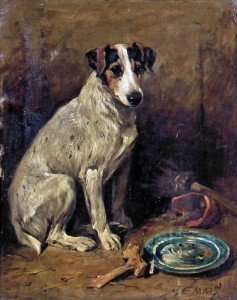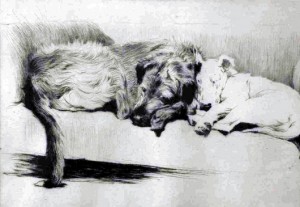LONDON – Lonely? Bored? Need to get fit? Buy a dog! We borrowed next door’s, a pretty little pooch called Bobbie, and a whole new life opened up. In the all-too-brief half-hour stroll – more like a dash given the dog’s enthusiasm – we talked to other dog lovers and got to inspect more lampposts and ends of walls than we realized existed along our stretch of street.
Or you could collect pictures of man’s best friend. You’ll never be bored or lonely with such companions on your walls, and with so many on offer – dogs must be among the most painted creatures of all – you’ll need plenty of stamina chasing them in the saleroom. Plus, there are no vet’s bills.
Paintings featuring dogs have exercised the minds and talents of an exhaustive list of artists. Our personal favourite is Cecil Aldin (1870-1935) a prolific book illustrator, cartoonist and accomplished painter who seemed almost incapable of completing a picture without including a dog.
The son of a wealthy builder in Slough, Berkshire, Aldin was educated with his two brothers at boarding school in Eastbourne, but later entered the National Art Training School in South Kensington. He later studied under Frank Calderon, a specialist animal painter, at a school devoted to the study of animal anatomy and painting.
Among Aldin’s first published work were drawings done at a dog show, which appeared in The Weekly Graphic in December 1890. He was paid the princely sum of three guineas, enough to rent a Chelsea studio. Work was not easy to come by, and in spare times between commissions for magazines, Aldin visited Regent’s Park Zoological Gardens to find “models” for sketches of more exotic creatures. This proved to be useful experience when he was asked to illustrate Rudyard Kipling’s Jungle Stories.
The drawings won acclaim when they were published in 1894, and there followed a steady stream of book and magazine work for an artist by now very much in demand. A founder member of the London Sketch Club, Aldin was elected to the Royal Society of British Artists in 1898. The following year, he won further acclaim with a set of six sporting prints showing horses and hounds, a particularly popular Aldin theme.
At about the same time, Aldin began to experiment with commercial poster production, a medium that clearly suited his inventive humour. In the event, he produced a wide range of adverts for such products as Zebra grate polish, Colman’s Blue and Starch, Rudge Whitworth Cycles and Cadbury’s Cocoa among many others.
He also became involved in producing wallpaper friezes and even handmade and painted rocking horses and other animals for children’s nurseries. There also followed a veritable avalanche of commissions to illustrate children’s books.
Another, perhaps less well known, aspect of Aldin’s work was a “travelogue” of old inns, coaching roads, cathedrals and his beloved Exmoor. Numerous books and prints flowed from his studio.
Latterly, Aldin began to suffer badly from arthritis, not helped by his frequent riding to hounds in all weathers, and he was advised to seek a warmer climate. He and his wife, Rita, moved to live in Majorca in 1930, where he built a studio. There he took up dry point etching and some writing, but his health declined further. Homesick and ill, Aldin decided to return to England but suffered a massive heart attack on board ship. He died in a London hospital in 1935.
Poor John Emms (1841-1912) was a dog artist of great ability, but his downfall was his near addiction to alcohol. Born into an artistic family in a village near Norwich, Norfolk, he was one of seven children for whom life was always going to be tough.
His big chance came in the 1870s, when he was invited by the celebrated Frederic Lord Leighton to accompany him to the New Forest to help paint the fresco of Lyndhurst Church. While doing so, he lodged in the village and met his future wife, Fanny Primmer, who at the time was still a schoolgirl.
They married in 1880 and had four children – three daughters and a son – and emigrated to New Zealand. However, their son died there and the family returned to Lyndhurst in 1883, moving into a house they had built on the edge of what was still then a village.
Perhaps it was the death of his son, or perhaps it was simply as his popularity as an artist began to wane, but Emms hit the whisky bottle. Bar bills at the Stag Hotel in Lyndhurst soared as Emms downed the drink in ever-increasing quantities, to the point where the money started to run out.
Thankfully, however, hotel host Ernest Harris was an art-lover – or else a very astute businessman – because he allowed Emms to finance his weakness in kind, handing over many of his oil paintings and sketches in payment.
Either Harris drove a hard bargain, or else Emms drank an extraordinarily large quantity of whisky, for when the landlord’s son emigrated to Australia in the 1960s, he took more than 100 paintings by the Stag’s best customer.
When two of those bartered paintings surfaced at auction in the 1990s – both featuring dogs – they sold together for £103,000, more than two and a half times estimate. Poor Emms could scarcely give them away in the 20 years before his demise in 1912 … except for another bottle of drink.
If it’s good pedigree you’re after, leading any roll call of must be Sir Edwin Landseer (1802-1873) the painter credited with starting the Victorian craze for dog pictures.
Landseer went as far as studying dissection and anatomy to perfect his drawing of animals and was subsequently commissioned by Queen Victoria to paint her pets. Patronage such as that ensured Landseer’s popularity, and a great many of his paintings were reproduced as engravings to be enjoyed by the less affluent.
He was also commissioned to model the bronze lions in Trafalgar Square and is well known for his Scottish scenes depicting Highland cattle. He is also worthy of mention for having also turned down the chance to be President of the Royal Academy, to which he was elected in 1865.
But then, he was like that. A melancholic man, he suffered from fits of depression – made worse by his liking for the bottle – and madness. He died in 1869 and is buried in St Paul’s Cathedral.
One strong contender for Landseer’s crown was Richard Ansdell (1815-1885). Ansdell was President of the Liverpool Academy and first exhibited at the Royal Academy in 1840, but he remains in the shadow of the master.
Maud Earl (fl.1884-1908) was another to be commissioned to paint the dogs kept by Queen Victoria and, later, King Edward VII. She specialized in sentimental pictures of dogs and dramatic paintings with such titles as Dogs of Death.
She had been influenced, no doubt, by her father, George (fl.1856-1883), who specialized in sporting scenes such as grouse shooting and stag hunting, while a third Earl, Thomas (fl.1836-1885), is best known for his pictures of dogs and rabbits.





